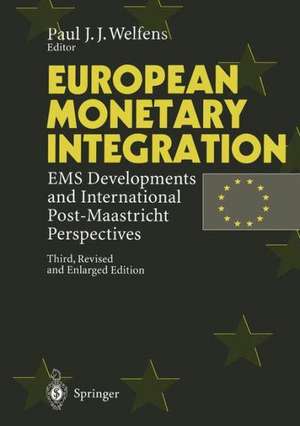European Monetary Integration: EMS Developments and International Post-Maastricht Perspectives
Editat de Paul J.J. Welfensen Limba Engleză Paperback – 14 dec 2011
Preț: 397.97 lei
Nou
Puncte Express: 597
Preț estimativ în valută:
76.15€ • 82.98$ • 64.17£
76.15€ • 82.98$ • 64.17£
Carte tipărită la comandă
Livrare economică 24 aprilie-08 mai
Preluare comenzi: 021 569.72.76
Specificații
ISBN-13: 9783642799716
ISBN-10: 364279971X
Pagini: 408
Ilustrații: XVIII, 384 p.
Dimensiuni: 170 x 242 x 21 mm
Greutate: 0.65 kg
Ediția:3rd ed. 1996. Softcover reprint of the original 3rd ed. 1996
Editura: Springer Berlin, Heidelberg
Colecția Springer
Locul publicării:Berlin, Heidelberg, Germany
ISBN-10: 364279971X
Pagini: 408
Ilustrații: XVIII, 384 p.
Dimensiuni: 170 x 242 x 21 mm
Greutate: 0.65 kg
Ediția:3rd ed. 1996. Softcover reprint of the original 3rd ed. 1996
Editura: Springer Berlin, Heidelberg
Colecția Springer
Locul publicării:Berlin, Heidelberg, Germany
Public țintă
ResearchCuprins
European Monetary Union: Post-Maastricht Perspectives on Monetary and Real Integration in Europe.- 1. European Monetary Integration after Maastricht.- 2. The Single Market Program and EC Monetary Integration.- 3. Transition Problems towards EMU.- Discussant: Randall Henning.- The European Monetary System and European Integration: An Evaluation.- 1. Introduction.- 2. European Macroeconomic Convergence.- 3. Macroeconomic Convergence and Economic Integration.- 4. Conclusion 70.- Data.- Discussant: Vittorio Grilli.- Basic Features of a European Monetary Order.- 1. Introduction.- 2. Facing the Challenge of an EC Monetary Order.- 3. The Need for Coherence of Fiscal and Monetary Policy.- 4. Perspectives.- Towards Monetary Union in the European Community: Why and How.- 1. Introduction.- 2. Where: The Meaning of Monetary Union.- 3. Why: Costs and Benefits from Monetary Union.- 4. How: Concrete Steps.- 5. Summary and Conclusions.- Discussant: Alan G. Isaac.- German Monetary Unification and European Monetary Union: Theoretical Issues and Strategic Policy Problems.- 1. Introduction.- 2. Are Germany and Europe Optimum Currency Areas?.- 3. German Monetary Unification.- 4. European Monetary Union.- 5. Big Leap for Germany and Gradualism for Europe.- Discussant: John Williamson.- Liberalization and Regulation in the Process of Financial Market Integration in the European Community 163.- 1. Introduction.- 2. The Historical Record.- 3. Liberalization and Regulation in the Commission’s New Approach.- 4. Likely Impact of the New Approach: Microeconomics.- 5. Likely Impact of the New Approach: Macroeconomics.- 6. Conclusions.- Discussant: Sydney J. Key.- Problems of European Monetary Policy Coordination in the Transition Phase.- 1. Introduction.- 2. Open Questions In Stage One.- 3. OpenQuestions of Stage 2.- 4. Conclusions.- Discussant: Horst Ungerer.- Creating a European Central Bank after 1992: Issues of EC Monetary Integration and Problems of Institutional Innovation.- 1. Monetary and Real Integration in the EC.- 2. The European Monetary System in Perspective.- 3. EC 1992 and Monetary Integration.- 4. Creating an EC Central Bank.- Discussant: George M. von Furstenberg.- Monetary and Fiscal Policy in a European Monetary Union: Some Public Choice Considerations.- 1. Introduction.- 2. Determinants of Inflation in a Monetary Union.- 3. The Role of Fiscal Policy in a Monetary Union.- 4. Conclusions.- Discussant: Robert Solomon.- Whan Can the Fiscal System in the United States and Canada Tell Us about EMU.- 1. Introduction.- 2. The Fiscal System in United States and Canada.- 3. The Relative Importance of Asymmetric Shocks.- 4. The Impact of Federal Taxes and Transfers in the United States and Canada.- 5. Redistribution and Stabilization in the EC.- 6. Conclusions 320.- Data/Appendix.- Discussant: Susan M. Collins.- The European Community as an Optimum Currency Area.- 1. Introduction.- 2. Model in a McKinnon Setting.- 3. Conclusion.- Discussant: Karen H. Johnson.- List of Contributors.- Appendix: Demand for Money and Currency Substitution in Europe.







